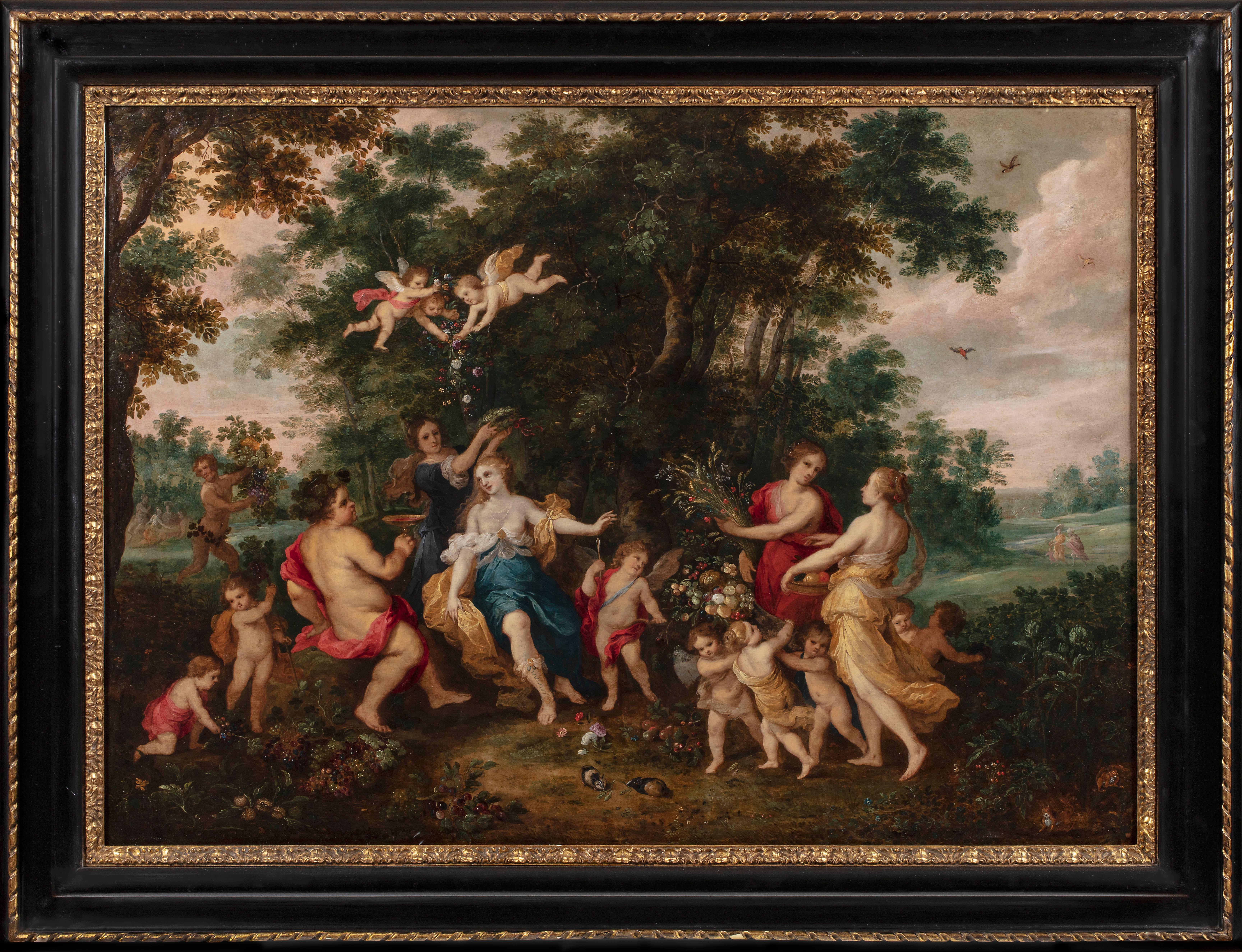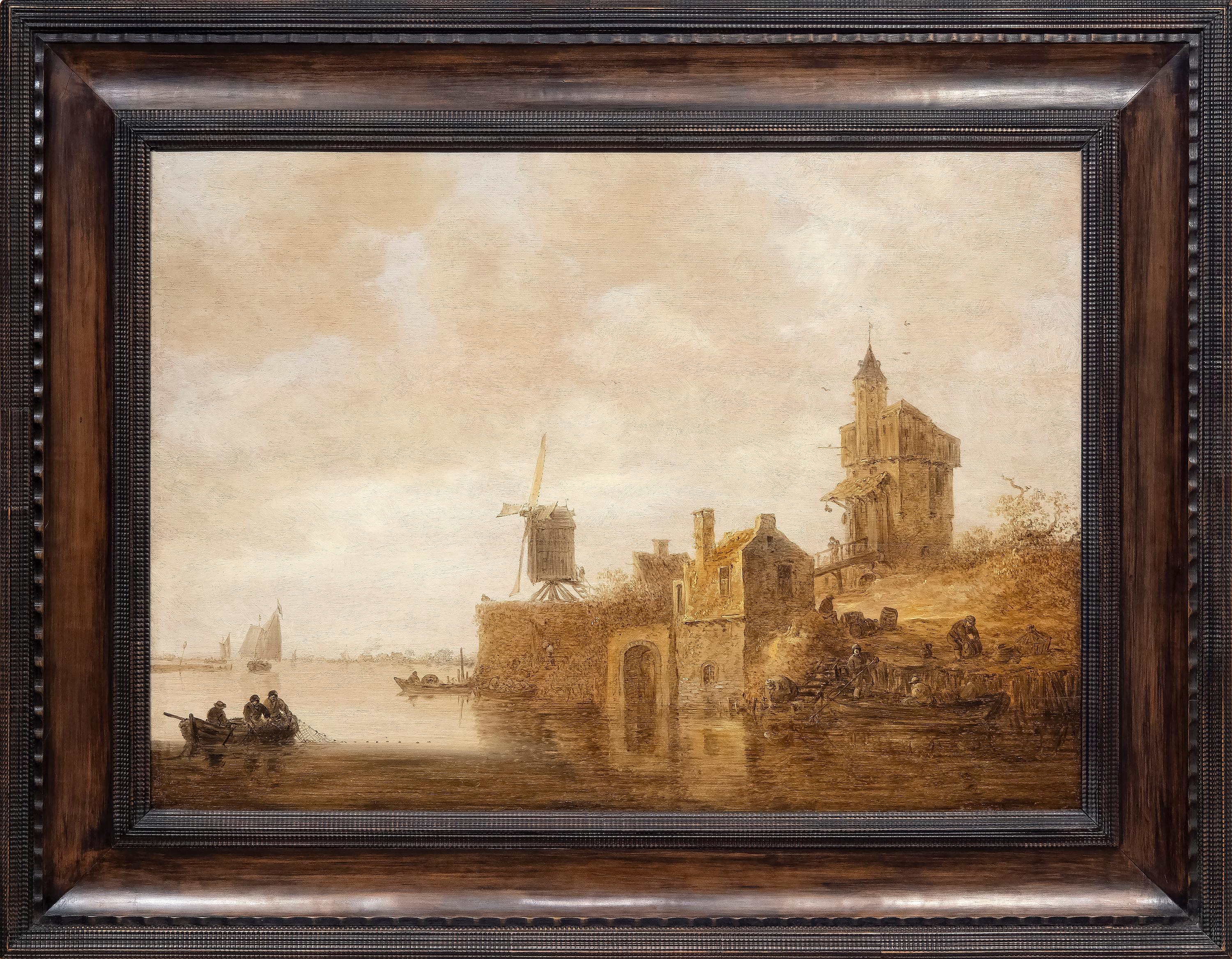Items Similar to Follower of Wouwerman Dutch School c1800 Oil Painting
Want more images or videos?
Request additional images or videos from the seller
1 of 9
UnknownFollower of Wouwerman Dutch School c1800 Oil Painting1800
1800
About the Item
Follower of Wouwerman Dutch School c1800
A delightful landscape painted on an oak panel, unsigned and dating from around 1800. The artist has deftly set the mood by placing his travellers silhouetted under a great arc of darkening clouds. It is reminiscent of the work of the 17th century Dutch artist Philips Wouwerman
Philips Wouwerman was celebrated for his paintings of hunting parties, battles and travellers on the road. Horses were a key element of his compositions and a white horse, such as the one depicted was his signature trade mark.
Born in Haarlem, the son of the painter Paulus Wouwerman, he was probably trained by his father and by Frans Hals. Wouwerman became a member of the Haarlem painters' guild in 1640 and his earliest dated paintings are of 1646.
Condition
Paint a little thin in places, age associated wear and the oak panel has split and been repaired in the distant past. The frame is probably original and has minor repairs.
Size
25cm x 38cm (43cm x 56cm framed)
10 x 15 inches (17 x 22 inches framed)
- Creation Year:1800
- Dimensions:Height: 10 in (25.4 cm)Width: 15 in (38.1 cm)
- Medium:
- Movement & Style:
- Period:
- Condition:
- Gallery Location:Holywell, GB
- Reference Number:
About the Seller
5.0
Gold Seller
These expertly vetted sellers are highly rated and consistently exceed customer expectations.
Established in 1989
1stDibs seller since 2023
20 sales on 1stDibs
Typical response time: <1 hour
- ShippingRetrieving quote...Ships From: Holywell, United Kingdom
- Return PolicyA return for this item may be initiated within 14 days of delivery.
More From This SellerView All
- After Hendrick MOMMERS (1623-1693) Haarlem Vegetable Market c1750Located in Holywell, GBAfter Hendrick MOMMERS (1623-1693) Haarlem Vegetable Market c1750 An early copy c1750, of an entertaining Dutch vegetable market scene in an Italianate landscape. The original was p...Category
1750s Old Masters Landscape Paintings
MaterialsOil
- French School Honfleur Mid 20th Century Oil PaintingBy Frank Myers BoggsLocated in Holywell, GBFrench School Honfleur Follower of Frank Myers BOGGS (1855-1926) A pleasing harbour scene depicting Honfleur in Northern France. Painted in an impressionistic style with great spontaneity using the dark brooding colour palette reminiscent of the work of Frank Boggs. Honfleur was the centre of a small artist’s colony during the late 19th and 20th centuries. Boggs concentrated on painting marine...Category
Mid-20th Century French School Landscape Paintings
MaterialsCanvas, Oil
- Maurice GRÜN (1869-1947) French Impressionist period Oil PaintingLocated in Holywell, GBMaurice GRÜN (1869-1947) Barge on a Canal A tranquil canalside painting of a horse-drawn barge by Maurice Grun. Signed bottom left, dating from the end...Category
Late 19th Century Impressionist Landscape Paintings
MaterialsOil
- Sovereign and Kurrewa America’s Cup Interest Oil PaintingBy Claude MuncasterLocated in Holywell, GBClaude MUNCASTER (1903-1974) Sovereign and Kurrewa America’s Cup Interest Oil Painting A sparkling depiction of the yachts Sovereign and Kurrewa in the 12 meter trial to determine t...Category
Mid-20th Century Impressionist Landscape Paintings
MaterialsOil
- Pierre Emmanuel Damoye (1847–1916) French Barbizon School Oil PaintingBy Pierre Emmanuel DamoyeLocated in Holywell, GBPierre Emmanuel Damoye (1847–1916) French Barbizon School A desolate snow covered landscape of fishing boats and nets drying on the banks of the river ...Category
Late 19th Century Impressionist Landscape Paintings
MaterialsOil
- Fernand Laval (1886-1966) Paris School Art Deco Period Oil PaintingBy Fernand LavalLocated in Holywell, GBFernand Laval (1886-1966) Paris School Art Deco Period La fete des Loges 1929 A delightful post impressionist painting of a fairground scene in Loges, n...Category
Early 20th Century Post-Impressionist Landscape Paintings
MaterialsOil
You May Also Like
- Grand 19th Century English Marine Painting in Stunning LightBy John Wilson EwbankLocated in London, GBJohn Wilson Ewbank (1799 - 1847) Shipping in the Harbour, South Shields Oil on canvas 39.5 x 58 inches unframed 47.75 x 66.5 inches framed Provenance: Christie's October 2002; Lot 11. Fine Art Society; Private Collection This marvellous up to scale Ewbank is full of light and warmth and almost certainly his greatest work of the sort rarely - if ever - seen on the market. John W. Ewbank (4 May 1799–28 November 1847), was an English-born landscape and marine painter largely operational from Scotland. The Humber river is a large tidal estuary on the east coast of Northern England. Life Ewbank was born at Darlington on 4 May 1799, the son of Michael Ewbank, an innkeeper. He was adopted as a child by a wealthy uncle who lived at Wycliffe, on the banks of the River Tees, in the North Riding of Yorkshire. Intended for the Roman Catholic priesthood, he was sent to Ushaw College, from which he absconded. In 1813 Ewbank was apprenticed to Thomas Coulson, an ornamental painter in Newcastle. In around 1816 he moved with Coulson to Edinburgh, where he had some lessons with Alexander Nasmyth. He found work both as a painter and a teacher. He was nominated in 1830 one of the foundation members of the Royal Scottish Academy. In 1833 he is listed as living at 7 Union Street on the eastern fringe of the New Town in Edinburgh. Works His sketches from nature were especially admired, and a series of 51 drawings of Edinburgh by him were engraved by W. H. Lizars for James Browne's Picturesque Views of Edinburgh (1825). He also made a reputation with cabinet pictures of banks of rivers, coast scenes, and marine subjects. As an illustrator he illustrated some early editions of Scott's Waverley Novels and one edition of Gilbert White...Category
19th Century Old Masters Figurative Paintings
MaterialsOil
- Important 18th Century Royal Academy Old Master Oil Painting of Georgian LondonLocated in Gerrards Cross, GB‘St. James’ Day’ by Richard Morton Paye (1750-1820). This very large and important 18th century oil on canvas depicts a diverse crowd of Londoners at an oyster stand on a summer’s ev...Category
1780s Old Masters Figurative Paintings
MaterialsOil
- Allegory of AbundanceLocated in New York, NYPainted in collaboration with Hendrick van Balen (Antwerp, 1575 – 1632). Provenance: Private Collection, Uruguay, since the 1930s. The eldest son of Jan Br...Category
17th Century Old Masters Paintings
MaterialsCopper
- A WolfLocated in New York, NYProvenance: The Marchesi Strozzi, Palazzo Strozzi, Florence Sale, Christie’s, London, May 20, 1993, lot 315, as by Carl Borromaus Andreas Ruthart...Category
17th Century Old Masters Animal Paintings
MaterialsPaper, Canvas, Oil
- River Landscape with a Windmill and ChapelBy Jan Josefsz Van GoyenLocated in Palm Desert, CA"River Landscape with a Windmill and Chapel" is a painting by Dutch Old Master Painter, Jan van Goyen. There are traces of a signature on the bow of the boat...Category
1640s Old Masters Landscape Paintings
MaterialsPanel, Oil
- Early oil depicting the Great Fire of LondonLocated in London, GBThe Great Fire of London in September 1666 was one of the greatest disasters in the city’s history. The City, with its wooden houses crowded together in narrow streets, was a natural fire risk, and predictions that London would burn down became a shocking reality. The fire began in a bakery in Pudding Lane, an area near the Thames teeming with warehouses and shops full of flammable materials, such as timber, oil, coal, pitch and turpentine. Inevitably the fire spread rapidly from this area into the City. Our painting depicts the impact of the fire on those who were caught in it and creates a very dramatic impression of what the fire was like. Closer inspection reveals a scene of chaos and panic with people running out of the gates. It shows Cripplegate in the north of the City, with St Giles without Cripplegate to its left, in flames (on the site of the present day Barbican). The painting probably represents the fire on the night of Tuesday 4 September, when four-fifths of the City was burning at once, including St Paul's Cathedral. Old St Paul’s can be seen to the right of the canvas, the medieval church with its thick stone walls, was considered a place of safety, but the building was covered in wooden scaffolding as it was in the midst of being restored by the then little known architect, Christopher Wren and caught fire. Our painting seems to depict a specific moment on the Tuesday night when the lead on St Paul’s caught fire and, as the diarist John Evelyn described: ‘the stones of Paul’s flew like grenades, the melting lead running down the streets in a stream and the very pavements glowing with the firey redness, so as no horse, nor man, was able to tread on them.’ Although the loss of life was minimal, some accounts record only sixteen perished, the magnitude of the property loss was shocking – some four hundred and thirty acres, about eighty per cent of the City proper was destroyed, including over thirteen thousand houses, eighty-nine churches, and fifty-two Guild Halls. Thousands were homeless and financially ruined. The Great Fire, and the subsequent fire of 1676, which destroyed over six hundred houses south of the Thames, changed the appearance of London forever. The one constructive outcome of the Great Fire was that the plague, which had devastated the population of London since 1665, diminished greatly, due to the mass death of the plague-carrying rats in the blaze. The fire was widely reported in eyewitness accounts, newspapers, letters and diaries. Samuel Pepys recorded climbing the steeple of Barking Church from which he viewed the destroyed City: ‘the saddest sight of desolation that I ever saw.’ There was an official enquiry into the causes of the fire, petitions to the King and Lord Mayor to rebuild, new legislation and building Acts. Naturally, the fire became a dramatic and extremely popular subject for painters and engravers. A group of works relatively closely related to the present picture have been traditionally ascribed to Jan Griffier...Category
17th Century Old Masters Landscape Paintings
MaterialsCanvas, Oil
Recently Viewed
View AllMore Ways To Browse
Painting Antique White
Set Of Paintings Brown
Set Of Antique Paintings
Antique Oak Panels
Antique Painting Unsigned
Set Of Antique Oil Paintings
Antique Old Keys
Old Antique Keys
Brown And White Antique Paintings
Framed Antique Keys
Dutch 17
Dutch School Antique
Unsigned Landscape Oil Painting
Oil Paintings Of Battle
Old Paintings 17 Century
1809 Art
Antique Cloud Painting
Antique Guild




